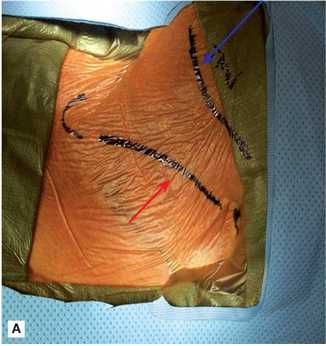[1]
Faateh M, Dakour-Aridi H, Kuo PL, Locham S, Rizwan M, Malas MB. Risk of emergent carotid endarterectomy varies by type of presenting symptoms. Journal of vascular surgery. 2019 Jul:70(1):130-137.e1. doi: 10.1016/j.jvs.2018.10.064. Epub 2019 Feb 15
[PubMed PMID: 30777684]
[2]
Rasheed AS, White RS, Tangel V, Storch BM, Pryor KO. Carotid Revascularization Procedures and Perioperative Outcomes: A Multistate Analysis, 2007-2014. Journal of cardiothoracic and vascular anesthesia. 2019 Jul:33(7):1963-1972. doi: 10.1053/j.jvca.2019.01.022. Epub 2019 Jan 9
[PubMed PMID: 30773439]
[3]
Lan Y, Lyu J, Ma X, Ma L, Lou X. Longitudinal assessment of cerebral blood flow changes following carotid artery stenting and endarterectomy. La Radiologia medica. 2019 Jul:124(7):636-642. doi: 10.1007/s11547-018-00986-7. Epub 2019 Feb 15
[PubMed PMID: 30771219]
[4]
Tyson AC, Parikh S, Singh K, Zia S, Deitch JS, Schor JA. Routine Postoperative Cardiac Testing is Unnecessary after Carotid Endarterectomy. Annals of vascular surgery. 2019 Aug:59():12-15. doi: 10.1016/j.avsg.2018.11.028. Epub 2019 Feb 13
[PubMed PMID: 30769059]
[5]
Babić S, Tanasković S, Nešković M, Gajin P, Nenezić D, Stevanović P, Aleksić N, Ševković M, Ilijevski N, Matić P, Popov P, Vučurević G, Unić-Stojanović D, Radak D. Surgical Treatment of Proximal Segmental Occlusion of the Internal Carotid Artery. Surgery research and practice. 2019:2019():2976091. doi: 10.1155/2019/2976091. Epub 2019 Jan 2
[PubMed PMID: 30719497]
[6]
Lamanna A, Maingard J, Barras CD, Kok HK, Handelman G, Chandra RV, Thijs V, Brooks DM, Asadi H. Carotid artery stenting: Current state of evidence and future directions. Acta neurologica Scandinavica. 2019 Apr:139(4):318-333. doi: 10.1111/ane.13062. Epub 2019 Feb 6
[PubMed PMID: 30613950]
Level 3 (low-level) evidence
[7]
Wang LJ, Ergul EA, Conrad MF, Malas MB, Kashyap VS, Goodney PP, Patel VI, Clouse WD. Addition of proximal intervention to carotid endarterectomy increases risk of stroke and death. Journal of vascular surgery. 2019 Apr:69(4):1102-1110. doi: 10.1016/j.jvs.2018.07.042. Epub 2018 Dec 13
[PubMed PMID: 30553728]
[8]
Texakalidis P, Giannopoulos S, Kokkinidis DG, Karasavvidis T, Rangel-Castilla L, Reavey-Cantwell J. Carotid Artery Endarterectomy Versus Carotid Artery Stenting for Patients with Contralateral Carotid Occlusion: A Systematic Review and Meta-Analysis. World neurosurgery. 2018 Dec:120():563-571.e3. doi: 10.1016/j.wneu.2018.08.183. Epub 2018 Sep 3
[PubMed PMID: 30189300]
Level 1 (high-level) evidence
[9]
Müller MD, Lyrer P, Brown MM, Bonati LH. Carotid artery stenting versus endarterectomy for treatment of carotid artery stenosis. The Cochrane database of systematic reviews. 2020 Feb 25:2(2):CD000515. doi: 10.1002/14651858.CD000515.pub5. Epub 2020 Feb 25
[PubMed PMID: 32096559]
Level 1 (high-level) evidence
[10]
Renard R, Davaine JM, Couture T, Jayet J, Tresson P, Gaudric J, Chiche L, Koskas F. Surgical repair of radiation-induced carotid stenosis. Journal of vascular surgery. 2020 Sep:72(3):959-967. doi: 10.1016/j.jvs.2019.11.034. Epub 2020 Feb 5
[PubMed PMID: 32035779]
[11]
Mayor JM, Salemi JL, Dongarwar D, Salihu HM, Montero-Baker M, Mills JL, Chung J. Sex-Based Differences in Ten-Year Nationwide Outcomes of Carotid Revascularization. Journal of the American College of Surgeons. 2019 Jul:229(1):38-46.e4. doi: 10.1016/j.jamcollsurg.2019.02.054. Epub 2019 Mar 26
[PubMed PMID: 30922980]
[12]
Naylor AR. Endarterectomy versus stenting for stroke prevention. Stroke and vascular neurology. 2018 Jun:3(2):101-106. doi: 10.1136/svn-2018-000146. Epub 2018 Feb 24
[PubMed PMID: 30022797]
[13]
Balucani C, Arnedo V, Weedon J, Leys D, Mas JL, Brown M, Grotta JC, Gonzales NR, Hacke W, Brott T, Levine SR. Transatlantic Differences in Management of Carotid Stenosis: BRIDGing the Gap in StrokE Management (BRIDGE) Project. The Neurohospitalist. 2018 Jul:8(3):113-123. doi: 10.1177/1941874417747772. Epub 2018 Jan 17
[PubMed PMID: 29977441]
[14]
Chung BH, Heo SH, Park YJ, Kim YW, Woo SY, Kim DI. Comparative Analysis Using Propensity Score Matching Analysis: Primary Closure versus Patch Angioplasty During Carotid Endarterectomy. Annals of vascular surgery. 2020 Jan:62():166-172. doi: 10.1016/j.avsg.2018.11.011. Epub 2019 Feb 11
[PubMed PMID: 30763710]
Level 2 (mid-level) evidence

